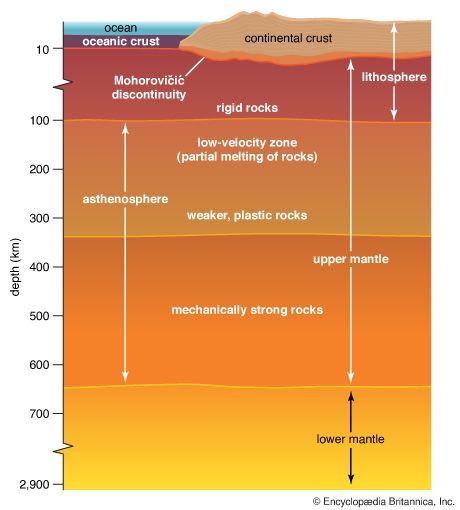Earth’s mantle
Learn about this topic in these articles:
Assorted References
- convection
- In plate tectonics: Mantle convection
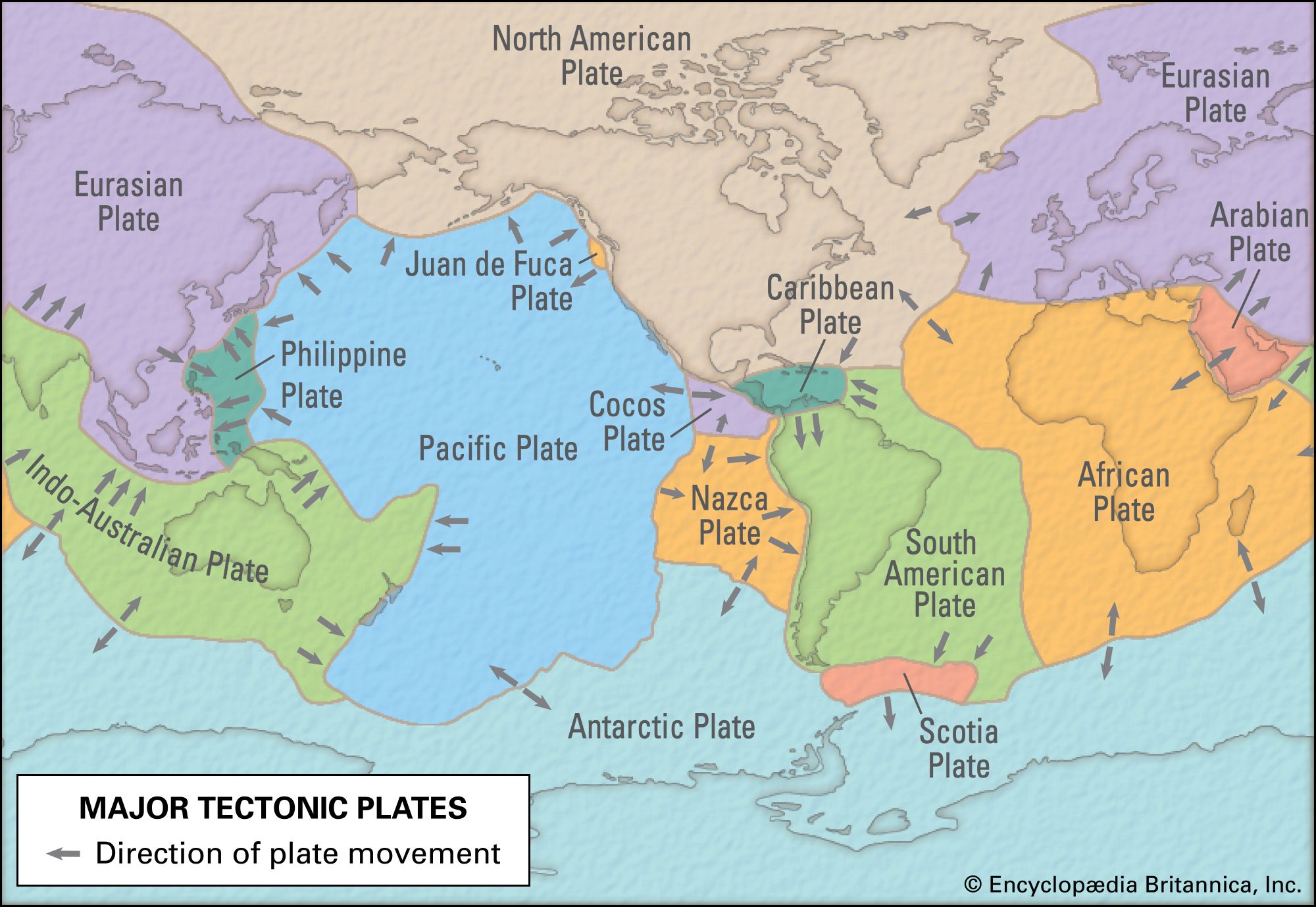
…of radioactive elements in the mantle. How this convection propels the plates is poorly understood. In the western Pacific Ocean the subduction of old dense oceanic crust may be self-propelled. The weight of the subducted slab may drag the rest of the plate toward the trench, a process known as…
Read More
- crust–mantle model
- In crust–mantle model
…observed about the crust, the mantle, and their interface. Many years ago, seismic evidence showed a discontinuity, called the Mohorovičić Discontinuity, anywhere from 3 to 60 kilometres (about 2 to 40 miles) beneath the Earth’s surface. The model used to explain this discontinuity and the nature of volcanic materials envisions…
Read More
- In crust–mantle model
- formation
- In geologic history of Earth: The pregeologic period
Once Earth’s interior (or its mantle) was hot and liquid, it would have been subjected to large-scale convection, which may have enabled oceanic crust to develop above upwelling regions. Rapid recycling of crust–mantle material occurred in convection cells, and in this way the earliest terrestrial continents…
Read More
- In geologic history of Earth: The pregeologic period
- mechanics of aftershocks and magma
- In mechanics of solids

…the hot rocks of the Earth’s mantle. When a large earthquake occurs, an associated deformation disturbance called a seismic wave propagates through the adjacent rock, and the entire Earth is set into vibrations which, following a sufficiently large earthquake, may remain detectable with precise instruments for several weeks. The rocks…
Read More
- mineral deposits
- In mineral deposit

…below the crust lies the mantle. Mineral deposits may occur in the mantle, but with present technology it is not possible to discover them.
Read More
- oceanic crust
- In marine ecosystem: Geography, oceanography, and topography
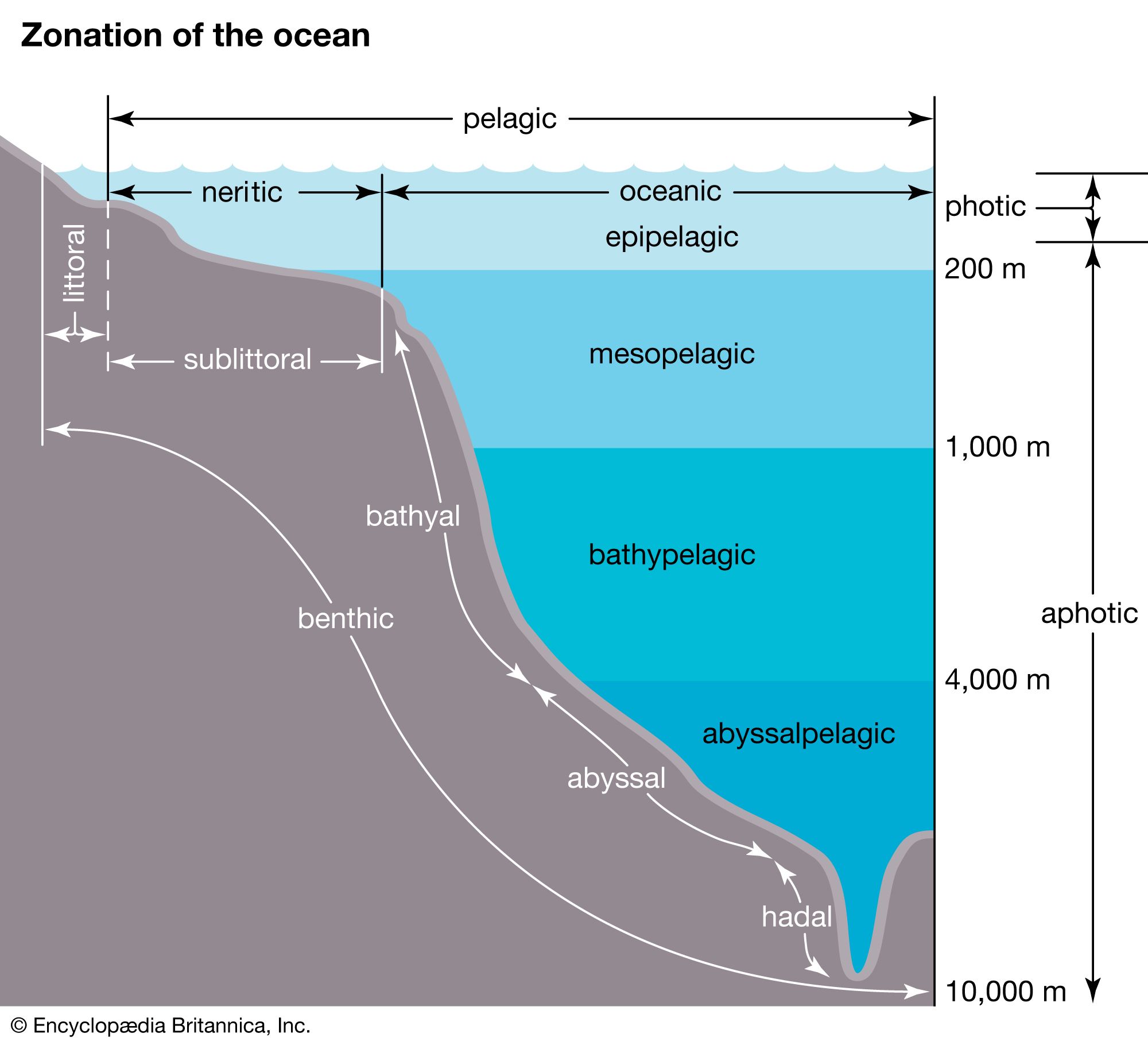
…on the surface of the Earth’s mantle, diverging, converging, or sliding against one another. When two plates diverge, magma from the mantle wells up and cools, forming new crust; when convergence occurs, one plate descends—i.e., is subducted—below the other and crust is resorbed into the mantle. Examples of both processes…
Read More
- plate tectonics
- In plate tectonics: Earth’s layers

…sit on top of the mantle, which is ultramafic in composition (i.e., very rich in magnesium and iron-bearing silicate minerals). The boundary between the crust (continental or oceanic) and the underlying mantle is known as the Mohorovičić discontinuity (also called Moho), which is named for its discoverer, Croatian seismologist
Read More
- scientific exploration
- In Earth exploration: Conclusions about the deep Earth

…to a spherically symmetrical crust–mantle–core picture of the Earth. The crust–mantle boundary is marked by a fairly large increase in velocity at the Mohorovičić discontinuity at depths on the order of 25–40 kilometres on the continents and five–eight kilometres on the seafloor. The mantle–core boundary is the Gutenberg discontinuity…
Read More
- seafloor spreading hypothesis
- In seafloor spreading

…postulated that molten material from Earth’s mantle continuously wells up along the crests of the mid-ocean ridges that wind for nearly 80,000 km (50,000 miles) through all the world’s oceans. As the magma cools, it is pushed away from the flanks of the ridges. This spreading creates a successively younger…
Read More
- structure of lithosphere
- In Earth: The outer shell

…marks the interface with the mantle. The mantle is composed of denser rocks, on which the rocks of the crust float. On geologic timescales, the mantle behaves as a very viscous fluid and responds to stress by flowing. Together the uppermost mantle and the crust act mechanically as a single…
Read More
- study by Mohorovičić
- In Andrija Mohorovičić
…boundary between Earth’s crust and mantle—a boundary subsequently named the Mohorovičić discontinuity.
Read More
- In Andrija Mohorovičić
composition
- chemical elements
- In chemical element: The Earth’s mantle
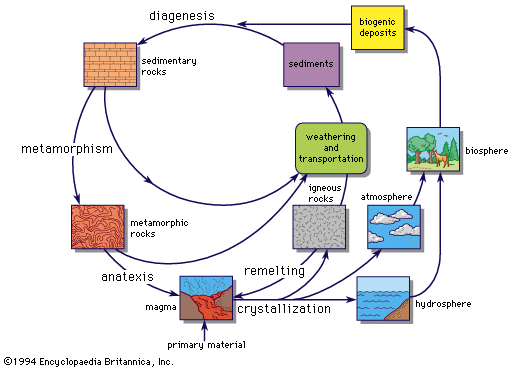
The mantle comprises that part of the Earth between the Mohorovičić and the Wiechert–Gutenberg discontinuities. It makes up 83 percent of the volume of the Earth and 67 percent of its mass and is thus of decisive importance in determining the bulk composition…
Read More - In chemical element: Early history of the Earth

For the mantle and the core the information is indirect and thus much less precise. The origin of the Earth by the accretion of planetesimals is a well-founded hypothesis, however, and meteorites are probably examples of planetesimals that have survived from the preplanetary stage of the solar…
Read More
- eclogite facies
- In eclogite
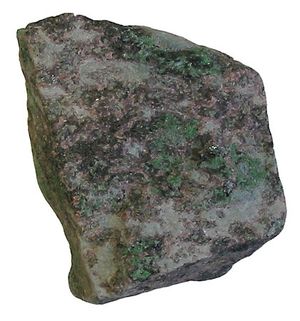
…the deeper portions of the Earth’s upper mantle, the mantle constituting the layer that lies between the crust and core and that comprises about two-thirds of the planet’s bulk. These conditions are found in subduction zones where the ocean floor is forced beneath a continental margin—such as in the Cascadia…
Read More - In metamorphic rock: Eclogite facies

…that part of the upper mantle might be made of eclogite. Such a view is supported by eclogitic intrusions in volcanic rocks and by eclogitic inclusions in diamond-bearing kimberlite, which must come from the upper mantle. Some workers also think that eclogites found in metamorphic terrains in Norway, California, U.S.,…
Read More
- metamorphic rocks
- In metamorphic rock

Because most of Earth’s mantle is solid, metamorphic processes may also occur there. Mantle rocks are seldom observed at the surface because they are too dense to rise, but occasionally a glimpse is presented by their inclusion in volcanic materials. Such rocks may represent samples from a depth…
Read More
- olivines
- In forsterite-fayalite series
…most important constituents of the Earth’s mantle. Included in the series are the following varieties: forsterite magnesium silicate (Mg2SiO4) and fayalite iron silicate (Fe2SiO4).
Read More - In olivine: Meteorites and the Earth’s mantle

…the rocks of the upper mantle directly below the Mohorovičić discontinuity (Moho) are believed to consist of peridotite and garnetiferous peridotite that contain olivines as their most abundant minerals, it is important to establish their behaviour when subjected to high pressures. Study of the olivine-like compound magnesium germanate, Mg2GeO4, showed…
Read More
- In forsterite-fayalite series
- osmium
- In dating: Rhenium–osmium method

… is strongly concentrated in the mantle and extremely depleted in the crust, so that crustal osmium must have exceedingly high radiogenic-to-stable ratios while the mantle values are low. In fact, crustal levels are so low that they are extremely difficult to measure with current technology. Most work to date has…
Read More
- pyrolite
- In pyrolite
…mineralogic composition of the upper mantle of the Earth. The relative abundances of the principal metallic element components (except iron) are similar to those in chondritic meteorites and in the solar photosphere. Accordingly, it is reasonable to assume that to a first approximation these abundances are applicable to the entire…
Read More
- In pyrolite
- radioactive rocks
- In rock: Radioactive heat generation

…by partial melting of the upper-mantle and oceanic-crust rock. The radioactive elements tend to be preferentially driven off from these rocks for geochemical reasons. A compilation of heat productivities of various rock types is given in the Table.
Read More


